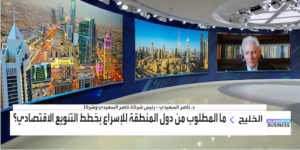Markets
In pre-holidays thin trade, the Dow Jones failed to touch the 20K mark which has been within striking distance for several days, as disappointing economic data failed to spur optimism and yields on 10-year Treasuries climbed to 2.55%. Other major bourses were rather stable, but emerging markets took another blow due to the rising dollar. Regional markets, on the contrary, were sustained by the oil price, with the exception of Saudi Arabia. The Kingdom announced an austere budget that aims, rather optimistically, to erase the deficit by 2020. In currency markets, the Bloomberg dollar spot index is close to levels not seen in more than a decade. The JPY had another good week, while the GBP sunk once again, as it becomes clear that the government is not able to frame a coherent Brexit strategy. Oil prices reached a 2016 high in the quiet trading session before Christmas, while gold prices were almost unchanged.
Global Developments
US/Americas:
- US real GDP, according to the final estimate, expanded 3.5% qoq ann, the best performance in two years after 1.4% in Q2. Consumption slowed from the overheated Q2 pace but was the main driver of growth. Exports and inventory investments were weak. Gross domestic income rose 4.8% qoq ann. after rising 0.7% in Q2.
- The Conference Board leading indicators index was constant in Nov, after rising 0.1% in Oct and 0.3% in Sep. The coincident indicator crawled up 0.1% and the lagging advanced 0.3%.
- Existing-home sales in the US increased by 0.7% mom (15.4% yoy) in Nov, the third consecutive monthly gain, due to a 10% jump in condo/co-op sales, while single-family home sales retreated 0.4% mom.
- US new-home sales in Nov increased 5.2% mom, down from 16.5% in Nov 2015.
- US unemployment claims rose 21,000 to 275,000. The four-week moving average increased 6,000 to 263,750. Continuing claims increased 15,000. The figures become volatile before the holidays so we need to wait at least two weeks for a return to normalcy.
- Durable manufactured goods orders in the US plunged 4.6% mom due to declining aircraft orders. Core capital goods orders rose 0.9% mom, the second gain in a row. Excluding transportation, new orders expanded 0.5%. Inventories went up 0.1%.
- Personal income in the US was almost flat mom in Nov, following a 0.5% increase in Oct. Nominal disposable income also stalled after a 0.5% rise in Oct. The personal saving rate dropped to 5.5%.
- US real spending rose 0.1% mom in Nov, the same as in Oct with durable goods down 0.1% mom.
- The US PCE deflator was unchanged mom in Nov vs 0.3% in Oct and 0.2% rise in Sep. Food prices remain fell 0.2%. Energy prices increased 1.3%, after two months of 3% gains. The monthly core PCE inflation was also zero.
- The University of Michigan’s consumer sentiment index was 98.2 in Dec vs 93.8 in Nov. The current economic conditions index rose by more than 4 points to 111.9. Consumer expectations surged to 89.5 a record in the current business cycle. Inflation expectations declined slightly.
- The Argentine GDP plunged -3.8% yoy in Q3 vs -3.7% in Q2. Private consumption slumped while fixed investment and exports also could not keep up.
Europe:
- The Eurozone’s current account surplus rose to EUR 28.4bn in Oct from EUR 27.7bn in Sep and EUR 24bn a year earlier. In the past 12 months the main factor driving the external account was energy prices.
- The German IFO index of business conditions climbed to 111 in Dec, the highest level since Feb 2012, and up form 110.4 in Nov. The German economy after years of resilience is showing signs of accelerating growth.
- The Conference Board Leading Economic Index for the Eurozone rose 0.3% mom to 108.2 in Nov. The Coincident Index, was unchanged at 102.7.
- UK consumer confidence improved marginally to -7 in Dec, from a reading of -8 in Nov. Overall uncertainty over Brexit clouds the horizon.
Asia and Pacific:
- The Bank of Japan kept its rate on excess reserves and the pace of QE unchanged in Dec and will continue to target long-term interest rates through a yield curve control policy. The inflation rate nevertheless seems unaffected.
- Singapore’s industrial production shot up 11.9% yoy in Nov from Oct’s 1.3% thanks to a jump in biomedicals and electronics.
- New Zealand GDP in Q3 expanded 1.1% qoq, up from 0.7% in Q2, thanks to higher private consumption, while exports constituted a slight drag.
- Taiwan’s industrial production increased 8.8 % yoy in Nov vs 3.4% in Oct with a strong performance in manufacturing.
Bottom line: Looking back at 2016, the major developments took place in the political realm, with Brexit and the election of Trump. While the first one is likely to end up as a footnote in the history books, the second, will determine the course of the global economy until the end of the decade. Expectations so far have been bullish but mostly based on an act of faith as Trumponomics has hardly taken shape. Hopes that the President-elect will deliver a massive spending plan collide with the reality that the ensuing interest rate increase would pose a serious threat to the US debt sustainability. Despite the optimism, so far actual data are not indicating a broad-based global growth acceleration, just a gradual improvement in the US.
Regional Developments
- Egypt is seeking to import crude oil directly from Iraq, revealed Egypt’s petroleum minister, instead of buying it from the international market.
- Egypt and the World Bank have signed an agreement for the disbursal of USD 1bn from the latter – the second of three disbursals of a USD 3bn loan.
- Kuwait’s central bank issued new governance rules for Islamic banks, including requirements for external sharia audits, independence of sharia boards as well as fit and proper criteria for scholars, among others. Islamic banks in Kuwait hold about 40% of total banking assets and these rules are to be fully implemented by Jan 2018.
- Oman’s central bank announced to have received competitive bids totaling OMR 268mn for a bond issuance OMR 150mn.
- Oman government posted a deficit of OMR 4.8bn in the first ten months of 2016, as revenues declined by 25% due to the slide of the oil prices.
- Oman’s population at the end of Nov was estimated at 4,546,830, a 0.3% increase over Sep figures.
- Qatari banks Masraf Al Rayan, Barwa Bank and International Bank of Qatar have begun initial talks for a potential merger, which could result in the second largest bank in the Gulf by assets (USD 44bn).
- Doha hotels rooms yield reported a 17.3% plunge to USD 136 in Nov this year, according to EY, as average room rate shrank 14.6% to USD 214 and there was also a 2% fall in occupancy to 63%.
- Jet fuel consumption in Qatar posted a demand growth of 96.6% between 2010 and 2016, according to research by BMI. To provide a reference, UAE’s jet fuel demand, second to Qatar, grew in excess of 51% during the same period.
- Saudi Arabia’s 2017 budget envisages an increase in spending by 6% to SAR 890bn, with spending on infrastructure set to rise 69%. Domestic fuel and electricity prices are set to rise – to be offset by cash payments to poorer citizens via a “Household Allowance” scheme, and an “expat levy” will be introduced from 2017.
- Saudi Arabia’s government has proposed an incentive package worth SAR 200bn to the private sector over the next four years. An investment fund will be established to provide capital that will facilitate investments, but no further details on the nature of incentives or fund’s operations were provided.
- Saudi Arabia’s 2016 budget deficit shrank to SAR 297bn versus a projected SAR 326bn, and from last year’s record gap of SAR 367bn. Actual spending was SAR 825bn compared with a projection of SAR 840bn.
- Saudi Arabia is planning to sell 49% of Aramco within 10 years, reported Al-Eqtisadiah, citing an unidentified senior government official.
- Saudi Arabia plans to borrow between USD 10-15bn from international markets in 2017 and around SAR 70bn from the domestic market, according to the secretary-general of the Finance Committee at the Royal Court.
- Saudi Arabia and Iraq reclaimed top two supplier ranks as India’s oil imports from Iran fell 19% in Nov from a record high the previous month. Supplies from Iran to India more than doubled in Jan-Nov to 468,900 barrels per day (bpd) from 205,900 bpd in the same period last year.
- China’s crude oil imports from Saudi Arabia jumped 29.2% yoy to 1.15 million barrels per day in Nov.
UAE Focus
- Dubai 2017 budget estimates a deficit of AED 2.5mn, or 0.6% of GDP, on account of higher spending, especially on infrastructure (+27% yoy). Of the estimated AED 47.3bn spending, 17% is set aside for infrastructure, to meet the needs of the upcoming Expo 2020. Revenues are projected to fall to about AED 44.8bn from AED 46.1bn this year; but, income from fees for government services (representing 76% of government revenues) is set to increase 6%.
- Overseas investments by UAE citizens touched nearly USD 9.3bn last year, with cumulative investments closer to USD 87.4bn,according to the Ministry of Economy.
- Revenues from VAT are likely to touch AED 12bn in the first year of introduction, subsequently rising to AED 18-20bn, revealed UAE’s Minister of State for Financial Affairs.
- Inflation in Dubai and Abu Dhabi rose to 3% and 2.4% respectively in yoy terms in Nov. In Dubai, housing and utility costs were up 4.2% while food prices cost 2.3% more.
- UAE is considering deregulation of cooking gas prices for its citizens: currently, Emirati families living in Abu Dhabi and Northern Emirates are permitted to buy AED 150 and AED 70 worth of subsidised cooking gas cylinders.
- Foreign investors bought shares worth AED 2.975bn or 48.3% of total trading value on Abu Dhabi Securities Exchange (ADX) in Nov this year. Net foreign investment during the month was roughly AED 13mn.
- Mubadala Development Company will hold Abu Dhabi’s new USD 2.2bn stake in BP, according to the government’s spokesman. This is part of the Adco concession deal was reached between the British oil giant and Abu Dhabi National Oil Company.
- Dubai South, which also includes the Al Maktoum Airport area, is expected to sustain a population of a million people and is designed to create 500,000 jobs when completed.
- Occupancy in Dubai hotels increased to 89.5% in Nov this year (vs. 84.4% in Nov 2015). The average daily rate of hotels in Dubai dropped by 8.6% yoy in Nov, and the revenue per average room fell by 3.6%.
Media Review
2016 – The Year in Money
https://www.bloomberg.com/graphics/2016-year-in-money/
Jumbo government deals lift 2016 sovereign emerging bond sales to record high
http://www.reuters.com/article/emerging-eurobonds-issuance-idUSL5N1EF4WD
Saudi 2017 budget highlights
https://www.bloomberg.com/news/articles/2016-12-22/main-features-of-saudi-arabia-s-2017-budget-2016-performance
https://www.bloomberg.com/news/articles/2016-12-22/saudi-arabia-sees-budget-deficit-falling-to-7-7-of-gdp-in-2017
Making the future hinges on readiness: UAE’s Sheikh Mohammad
http://gulfnews.com/news/uae/society/making-the-future-hinges-on-readiness-says-mohammad-1.1950672
Bahrain Year in Review 2016
http://www.oxfordbusinessgroup.com/news/bahrain-year-review-2016
Powered by:







